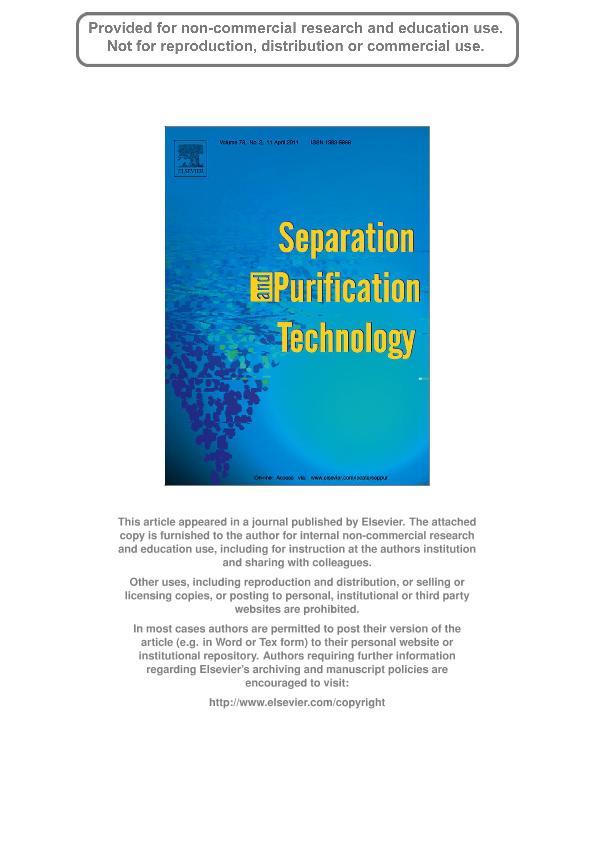Mostrar el registro sencillo del ítem
dc.contributor.author
Sosa, María Angélica

dc.contributor.author
Espinosa, Hector Jose Maria

dc.date.available
2021-08-05T19:00:20Z
dc.date.issued
2011-04-11
dc.identifier.citation
Sosa, María Angélica; Espinosa, Hector Jose Maria; Feasibility analysis of isopropanol recovery by hybrid distillation/ pervaporation process with the aid of conceptual models; Elsevier Science; Separation and Purification Technology; 78; 2; 11-4-2011; 237-244
dc.identifier.issn
1383-5866
dc.identifier.uri
http://hdl.handle.net/11336/137897
dc.description.abstract
In this contribution, main results of a techno-economic feasibility study to recover spent isopropyl alcohol (IPA) from a pre-treated waste stream composed by IPA (95.64 wt.%) and water (4.36 wt.%) are presented. Based on conceptualmodels for the unit operations, a quasi-optimal design for a hybrid process combining pervaporation and distillation is found under process specifications given by a pharmaceutical company. The proposed procedure allows a separated design of each unit with the aid of conceptual models. While distillation is evaluated from pinch theory, the conceptual model for pervaporation considers that the maximum driving force (i.e., no liquid temperature drop) is maintained across the membrane unit. A brief performance comparison for different membranes is also performed as part of the assessment to the company. For this purpose, the pervaporation separation index (PSI index) defined as the product of the permeate mass flux and the separation factor was used for membranes for which either literature data or membrane supplier brochures were available. In the case of the membrane PERVAP 2216 from Sulzer, several pervaporation experiments at 80 ◦C and permeate pressure of 1.52 kPa were carried out. The PSI index was then redefined as the overall separation factor times the inverse of the minimum membrane area required to perform a given separation. The results obtained emphasize the usefulness of conceptual modeling in all steps of process design.
dc.format
application/pdf
dc.language.iso
eng
dc.publisher
Elsevier Science

dc.rights
info:eu-repo/semantics/openAccess
dc.rights.uri
https://creativecommons.org/licenses/by-nc-sa/2.5/ar/
dc.subject
CONCEPTUAL MODELS
dc.subject
DISTILLATION
dc.subject
FEASIBILITY
dc.subject
HYBRID PROCESS
dc.subject
ISOPROPANOL RECOVERY
dc.subject
PERVAPORATION
dc.subject
PSI INDEX
dc.subject.classification
Ingeniería de Procesos Químicos

dc.subject.classification
Ingeniería Química

dc.subject.classification
INGENIERÍAS Y TECNOLOGÍAS

dc.title
Feasibility analysis of isopropanol recovery by hybrid distillation/ pervaporation process with the aid of conceptual models
dc.type
info:eu-repo/semantics/article
dc.type
info:ar-repo/semantics/artículo
dc.type
info:eu-repo/semantics/publishedVersion
dc.date.updated
2021-06-07T16:40:00Z
dc.identifier.eissn
1873-3794
dc.journal.volume
78
dc.journal.number
2
dc.journal.pagination
237-244
dc.journal.pais
Países Bajos

dc.journal.ciudad
Amsterdam
dc.description.fil
Fil: Sosa, María Angélica. Consejo Nacional de Investigaciones Científicas y Técnicas. Centro Científico Tecnológico Conicet - Santa Fe. Instituto de Desarrollo y Diseño. Universidad Tecnológica Nacional. Facultad Regional Santa Fe. Instituto de Desarrollo y Diseño; Argentina
dc.description.fil
Fil: Espinosa, Hector Jose Maria. Consejo Nacional de Investigaciones Científicas y Técnicas. Centro Científico Tecnológico Conicet - Santa Fe. Instituto de Desarrollo y Diseño. Universidad Tecnológica Nacional. Facultad Regional Santa Fe. Instituto de Desarrollo y Diseño; Argentina. Universidad Nacional del Litoral; Argentina
dc.journal.title
Separation and Purification Technology

dc.relation.alternativeid
info:eu-repo/semantics/altIdentifier/doi/http://dx.doi.org/10.1016/j.seppur.2011.02.009
dc.relation.alternativeid
info:eu-repo/semantics/altIdentifier/url/https://www.sciencedirect.com/science/article/abs/pii/S1383586611001006
Archivos asociados
